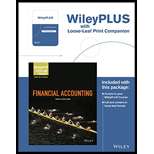
Concept explainers
Accounts receivable
Accounts receivable refers to the amounts to be received within a short period from customers upon the sale of goods and services on account. In other words, accounts receivable are amounts customers owe to the business. Accounts receivable is an asset of a business.
Allowance method:
It is a method for accounting bad debt expense, where uncollectible accounts receivables are estimated and recorded at the end of particular period. Under this method,
Write-off:
Write-off refers to deduction of a certain amount from accounts receivable, when it becomes uncollectible.
To Journalize: The
Want to see the full answer?
Check out a sample textbook solution
Chapter 8 Solutions
Financial Accounting, 10e WileyPLUS Registration Card + Loose-leaf Print Companion
- What is the correct answer with accounting questionarrow_forwardGrouper Corporation purchased machinery on January 1, 2025, at a cost of $264,000. The estimated useful life of the machinery is 4 years, with an estimated salvage value at the end of that period of $31,400. The company is considering different depreciation methods that could be used for financial reporting purposes. (a) Your answer is partially correct. Prepare separate depreciation schedules for the machinery using the straight-line method, and the declining-balance method using double the straight-line rate. STRAIGHT-LINE DEPRECIATION epreciation Rate 50 % do do % End of Year Annual Depreciation Expense Accumulated Depreciation Book Value +A 58150 $ +A % do do % 58150 58150 58150 +A $ 232600arrow_forwardI want helparrow_forward
- Solve thisarrow_forwardA company analyzing its break-even point for a product with a selling price of $85 per unit. The variable cost per unit is $53, and the fixed costs are $187,000 per year. If the company wants to achieve a profit of $76,000, how many units must it sell to meet this profit goal? (Round answer to nearest unit)arrow_forwardThe supervisor at Grace Diner analyzed the weekly food waste report. According to restaurant standards, waste should not exceed 3.5% of weekly food cost. With total food costs of $9,250, actual waste recorded was $397. Management needs the variance from acceptable waste limit to be determined for staff evaluation. Helpyarrow_forward

 AccountingAccountingISBN:9781337272094Author:WARREN, Carl S., Reeve, James M., Duchac, Jonathan E.Publisher:Cengage Learning,
AccountingAccountingISBN:9781337272094Author:WARREN, Carl S., Reeve, James M., Duchac, Jonathan E.Publisher:Cengage Learning, Accounting Information SystemsAccountingISBN:9781337619202Author:Hall, James A.Publisher:Cengage Learning,
Accounting Information SystemsAccountingISBN:9781337619202Author:Hall, James A.Publisher:Cengage Learning, Horngren's Cost Accounting: A Managerial Emphasis...AccountingISBN:9780134475585Author:Srikant M. Datar, Madhav V. RajanPublisher:PEARSON
Horngren's Cost Accounting: A Managerial Emphasis...AccountingISBN:9780134475585Author:Srikant M. Datar, Madhav V. RajanPublisher:PEARSON Intermediate AccountingAccountingISBN:9781259722660Author:J. David Spiceland, Mark W. Nelson, Wayne M ThomasPublisher:McGraw-Hill Education
Intermediate AccountingAccountingISBN:9781259722660Author:J. David Spiceland, Mark W. Nelson, Wayne M ThomasPublisher:McGraw-Hill Education Financial and Managerial AccountingAccountingISBN:9781259726705Author:John J Wild, Ken W. Shaw, Barbara Chiappetta Fundamental Accounting PrinciplesPublisher:McGraw-Hill Education
Financial and Managerial AccountingAccountingISBN:9781259726705Author:John J Wild, Ken W. Shaw, Barbara Chiappetta Fundamental Accounting PrinciplesPublisher:McGraw-Hill Education





